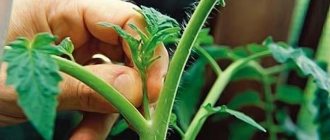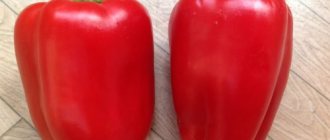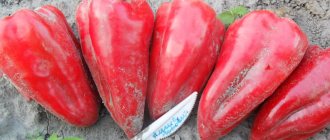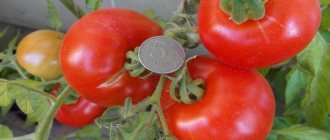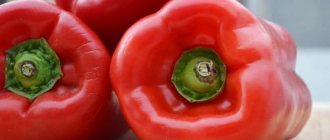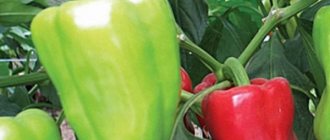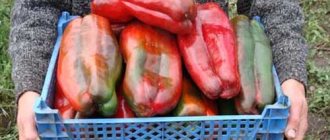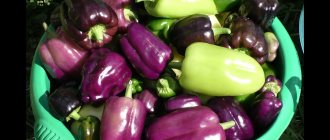Characteristics of the variety
This variety is an early hybrid of sweet pepper.
The first harvest appears after 100-115 days. According to the description, the Danai f1 hybrid pepper is easy to care for and has a lot of positive qualities:
- early ripeness of fruits;
- high yields;
- stress resistance;
- sunburn resistance;
- disease resistance.
Description of the bush
Medium sized bush with large roots. The plant is powerful, heavily leafy. During the fruiting period, up to 12 fruits are formed on one bush. During the season you can get from 8 kg to 10 kg per 1 sq. m.
Description of the fruit
The fruit is cone-shaped, smooth, and medium in size. The color at harvest is white-cream. After ripening, the fruits acquire a bright red color. The average weight of the fruit is from 140 g to 180 g. They reach 13-15 cm in length. 3-4 cm in width. Wall thickness is from 5 to 7 mm.
Varieties of bell pepper for Siberia
| One of the earliest ripening varieties (85-95 days). The plant is compact, low-growing, 40-50 cm high, with shortened internodes and a bouquet arrangement of fruits. 6-8 fruits are formed and ripen on the plant at the same time. The fruits are drooping, prism-shaped, smooth, as they ripen, the color changes from white-yellow - orange to intense red, the number of nests is 3 - 4, weighing 100-130 g. Wall thickness 6-8 mm. The pulp is dense and juicy. The variety is resistant to unfavorable growing conditions and temperature changes. Suitable for starting to harvest fruits already at technical ripeness, can be stored for a long time and can be easily transported. Due to its early ripening, it perfectly adapts to the weather conditions of Central Russia, West Siberian and Ural and Southern regions. The purpose is universal. Productivity 50-60 t./ha. |
Sweet pepper Arctic F1
| An early ripe hybrid for growing in open ground and film greenhouses. The fruits are elongated-cylindrical, dark red in color, weighing 90-100 g, with a delicate taste and strong aroma, wall thickness up to 5-7 mm. The value of the hybrid: high yield, friendly early harvest, high content of ascorbic acid in fruits, excellent taste of fresh and processed products. The fruits are transportable and well stored. |
Sweet pepper Chief of the Redskins
| Early ripening large-fruited variety. The plant is powerful. Standard bush, 55-60 cm. The fruits are cube-shaped, dark, fleshy, green when technically ripe, weighing 156-400 g, thick-walled (6-8 mm), excellent taste. The variety is resistant to diseases. Can be grown after carrots, cabbage, beets, legumes (except beans) and pumpkin crops. Pepper should not be placed next to cucumber. Grown by seedlings. To obtain seedlings, seeds are sown in February in seed boxes with soil mixture. Boxes covered with film (glass) are placed in a warm place. The optimal temperature for seed germination is 23-25°C. Planted in open ground in early June. |
Sweet pepper Lilac Glitter
| Early ripening variety. The plant is semi-spreading, of medium height. Original lilac fruits in technical ripeness, dark red in biological ripeness. The fruit is drooping, cone-shaped, weighing 57-150 g. Good taste and commercial quality. Suitable for growing in film greenhouses and open ground. Can be grown after carrots, cabbage, beets, legumes (except beans) and pumpkin crops. Pepper should not be placed next to cucumber. Grown by seedlings. To obtain seedlings, seeds are sown in February in seed boxes with soil mixture. Boxes covered with film (glass) are placed in a warm place. The optimal temperature for seed germination is 23-25°C. Planted in open ground in early June. |
Sweet pepper Fat Baron
| An early-ripening large-fruited variety for growing in open and protected ground. From germination to technical ripeness of fruits 90-100 days. The plant is 100-120 cm high. The fruits are very large, prism-shaped, bright red in color, weighing 200-500 g. The thickness of the fruit wall is up to 8 mm. The variety is resistant to tobacco mosaic virus. The yield of the variety is 7-14 kg. from 1 sq. m. depending on growing conditions. To obtain high yields, it is recommended to place 3-5 plants per 1 square meter when planting in a permanent place. m., during the growing season, carry out regular feeding and watering. |
Sweet pepper Golden calf
| A varietal form of a famous hybrid, adapted to Siberian conditions. The variety is mid-early, low-growing bush, 70-75 cm high. The fruits are yellow-orange, very large and fleshy. The weight of the fruit is 250-500 g, the wall thickness is up to 1 cm. The taste of the fruit is worthy of the highest praise! The variety is very productive - up to 14 large fruits per plant. Recommended for growing in open and protected ground. For 1 sq. m. no more than 5 plants are placed. To obtain higher yields, regular fertilizing with complex mineral fertilizers and watering of plants is necessary. |
Sweet pepper 2022
Messages: 6434 Registered: 10/29/2012, 06:35 From: Moscow, dacha in Chekhov district, Moscow Region Thanked: 1363 times Thanked: 5964 times
Status: Offline
Sweet pepper 2018
Posted by ninyureva » 01/14/2018, 12:07
Girls, criticize me, I made a list for planting this year, is it worth sowing these varieties/hybrids? 1. Gogoshary from the village 2. Golden calf 3. Tondo Rosso 4. Stryama 5. Cherry wine 6. Hostess 7. Yellow from the buckwheat bed 8. Snowdon 9. Hungarian Ratund 10. Amphora 11. Bulgarian 12. Gipsy 13. Fisht 14 .Belozerka 15.Samander 16.Gemini f1 17.Ramiro 18.Miracle Paprika 19.Elephant Trunk 20.Goros 21.Trebia
Messages: 12715 Registered: 03/19/2010, 16:39 Interests: Various From: Moscow Northern Administrative Okrug dacha behind Istra Thanked: 5530 times Thanked: 8782 times
Status: Offline
Sweet pepper 2022 – 2
Message from Kuzinamama » 01/14/2018, 12:15
Messages: 2733 Registered: 09/25/2009, 01:49 From: Moscow, dacha north Moscow Region Thanked: 2404 times Thanked: 1219 times
Status: Offline
Sweet pepper 2022 – 2
Message from KryzIr » 01/14/2018, 12:22
Messages: 2733 Registered: 09/25/2009, 01:49 From: Moscow, dacha north Moscow Region Thanked: 2404 times Thanked: 1219 times
Status: Offline
Sweet pepper 2022 – 2
Message from KryzIr » 01/14/2018, 12:24
Messages: 12715 Registered: 03/19/2010, 16:39 Interests: Various From: Moscow Northern Administrative Okrug dacha behind Istra Thanked: 5530 times Thanked: 8782 times
Status: Offline
Sweet pepper 2022 – 2
Message from Kuzinamama » 01/14/2018, 12:27
The Gogoshars from the village and the Hostess are productive, thick-fleshed, of the Gogoshar type, very similar, some of them are dark at technical ripeness, and some are light. I forgot who exactly, but otherwise they are similar. They don't react well to the cold and begin to rot, so don't sow too early, so as not to rush into planting in the garden. Rely on them, but not too much, if the summer is cold, they will let you down. The Bulgarian must be sown, leveled, for stuffing, a lot, quite early. There’s a lot of it, but the shape is such that I don’t know where it goes. I won't sow. Tondo Rosso, thick meat, good for lecho. Amphora - beautiful, but there was little on the bush. I didn’t remember it somehow, I should repeat it, maybe I didn’t try it, Cherry wine, also the form is such that I don’t know what it is for and where, I won’t plant it again. Goros is a must-plant, it’s the most delicious and aromatic I’ve ever had. In the fall, I remember making a promise to myself to plant only this one for the next year.
Nord King needs to sow, in fact he was completely calm about the cold. If suddenly it’s summer like this again, he won’t let you down.
How to care for early varieties of sweet peppers
Further care for this vegetable crop will not be difficult even for a beginner. Pepper requires:
- Abundant watering with warm, settled water.
- Periodic loosening (shallow, since the pepper has shallow roots) to prevent the formation of a crust, and hilling.
- Removal of weeds in the hole and between rows.
- Tying tall varieties to a support.
- At least 3-4 feedings during the growing season. 2 weeks after planting, mineral fertilizers are applied (superphosphate, urea - 20 g per 10 liters of water). During flowering, every 10–15 days, feed with organic matter at the root (1 kg of chicken droppings or 2 kg of manure per 10 liters of water, add ash (0.5–1 liter) and herbal infusions) and spray with growth stimulants (Epin, Ovary) to prevent flowers and ovaries from falling off.
- Preventive treatments, since early ripening peppers may get sick during June thunderstorms or cold snaps.
Ultra-early early ripening plants, regardless of their height, practically do not require formation. Entering fruiting early, they are sensitive to any type of fertilizing, which allows them to prolong flowering and fruit set. Experts also suggest that the first shoots that form just below the branching of the central stem are removed from such cultivars.
At the end of the season, flowers, ovaries and small pepper fruits that have not yet ripened are also removed, then the bushes are thoroughly loosened at the base, it is believed that this speeds up the process of fruit formation
Sweet pepper D'Artagnan
405
Total views Total grown
2
Growing now This plant
Description
Characteristics
Growing and care
Have you grown this plant?
Where can I buy
Photos
All reviews (0)
Growing seedlings
Soil for sowing
The soil for sowing peppers should be moist and breathable, fertile and loose. Pepper loves good soil moisture and is very sensitive to overheating and drying out.
Sowing seeds
Seeds must be disinfected and soaked before planting. They can be disinfected in 1% potassium permanganate (dipped into the solution for 20-30 minutes, then rinsed thoroughly with water), hydrogen peroxide, aloe or solutions of biological products. After disinfection, to increase germination, the seeds can be soaked in water or some kind of stimulant. Sow the seeds in pre-prepared containers to a depth of 1 cm. Pepper seedlings sprout on days 5-15 at a temperature of 25°-28°C. Dry seeds take longer to germinate. At temperatures below 15°C, the seeds will not germinate at all.
Lighting
Pepper is a light-loving plant; pepper seedlings require additional lighting.
Hardening
2-3 weeks before planting, the seedlings are taken out onto the balcony, veranda, and the windows are opened slightly (without drafts) so that the seedlings get used to the low temperature. During hardening, monitor the weather conditions; you must not allow the pepper seedlings to be exposed to frost or low temperatures - for pepper this is below +13°C.
Good predecessors:
Beans Zucchini Cabbage Onion Carrots Cucumber Patisson Pumpkin Beans Siderates
Predecessors are bad:
Eggplant Potatoes Pepper Tomato Physalis
Planting scheme
Peppers are planted according to a 40x40 cm pattern. The planting depth is the height of the pot. Overgrown seedlings are planted obliquely, but the stem is not planted deep, because pepper does not form additional roots well.
Watering and humidity
Pepper loves good soil moisture and is very sensitive to overheating and drying out.
Agricultural technology
Planting seedlings (features)
When stable warm weather sets in (night temperatures do not fall below 10°C, and daytime temperatures are 15-17°C). You can start planting seedlings in the greenhouse. Humus is added at the rate of 8-10 kg per square meter, superphosphate and potassium sulfate at 30-40 g. per 1 square meter (fertilizers can be applied immediately before planting, 1 teaspoon in each hole).
Growing tall peppers in greenhouses
Even if your greenhouse is well equipped for early growing of pepper, do not forget that this is a heat-loving crop that requires regular watering and additional nutrition. In addition, tall peppers require gartering of branches, and for this in closed ground conditions it is necessary to install additional supports or a lattice mesh.
Specially bred varieties of sweet peppers for growing in different climatic conditions are Orange Miracle, Nochka and Winnie the Pooh. On the shelves of shops and markets you can find planting material of the varieties Victoria, Othello, Health and Elephant, which are also suitable for greenhouses and greenhouses, but require some additional growing conditions.
Even in conditions of round-the-clock air heating and good lighting, greenhouse varieties of tall peppers have individual growth and growing seasons and produce stable and tasty harvests with regular watering and fertilizing.
The only criteria for a stable harvest, characteristic of all varieties of tall peppers, are the conditions for planting them:
- It is necessary to begin sowing planting material and growing seedlings in March, at the first signs that the air temperature has begun to rise and there will no longer be a downward trend;
- Seeds are prepared for planting, disinfected and pecked, and then placed in planting containers or specially prepared boxes. Fertile black soil or moistened compost is used as planting soil. Tall sweet peppers are sensitive to low nutrient levels in the soil;
- If planting material is planted in boxes, observe the following norm: the hatched grains are placed into the ground at a distance of at least 2 cm;
- Growing seedlings also requires a certain temperature regime - it should not be less than 22-23 0 C.
Before transferring seedlings to greenhouse conditions, you need to prepare the soil. The substrate in the beds should be at least 25-30 cm thick. If the variety of tall sweet pepper you have chosen requires feeding with organic fertilizers, add them in small quantities.
The seedlings are transferred to 55-60 days after the seed has been pecked, when the pepper bush has gained a height of 25-30 cm. Tall varieties, with appropriate hardening and germination of the planting material, quickly produce additional leaves. By the time the plant is transferred to a greenhouse or greenhouse, there must be at least 5 leaves on the stem.
During the growth process, tall varieties of sweet bell peppers are tied up or supported with wooden supports. At the same time, the bush is constantly dived, leaving the strongest and healthiest shoot.
A prerequisite for growing tall varieties of peppers is regular loosening of the soil. In order for the root of a plant to be strong and healthy, it must be supplied with oxygen. Compacted soil will interfere with this.
Diseases and pests
These peppers are less susceptible to disease
Aden F1 pepper has good resistance to all diseases. Even good immunity may not save you from disease if all the rules of care have not been followed.
Diseases
Beginner gardeners are confused when faced with diseases, but there is nothing particularly scary about them. The main thing is timely prevention.
- Verticillosis belongs to the category of fungal diseases. The danger of such a disease is that it cannot be treated, that is, if the plant is infected, the bush will die in any case. The risk of peppers becoming infected with this fungus increases when bushes are grown in conditions of high air and soil humidity.
- Stolbur - belongs to the category of infectious diseases. It appears on bushes as a sharp yellowing of a large number of leaves. The second stage of infection will be the deformation of unformed fruits and young leaves.
- Cladosporiosis is also included in the category of fungal diseases. The disease manifests itself as rot on leaves and stems. If the plant is already infected, you need to completely stop watering for 5 days. Immediately clean the bush from infected areas, treat the stems and use a solution of foundationazole: 1 liter of water, 20 g of foundationazole.
It is easiest to defeat diseases in the first stages. To identify the first stages of the onset of the disease, it is necessary to conduct inspections of plants.
If the plant has already become severely deteriorated due to disease, it must be destroyed. As long as there is one diseased plant, all other healthy ones are in danger
Pests
Pests are no less a dangerous problem for plants than diseases, fungi and viruses:
- The Colorado potato beetle belongs to the category of the most dangerous pests. These insects are particularly voracious; 5-6 individuals can destroy a bush in a day. This beetle can be controlled only with the use of specialized chemicals, strictly following the instructions.
- Slug - this pest feeds on the young leaves of the plant and thereby jeopardizes the further growth and development of the plant. The easiest way to fight slugs is mechanically, that is, collect all the insects by hand.
- Aphids are the most dangerous pest for vegetable crops. These beetles multiply very quickly, and within a week from the moment the first insects appear, the colony reaches such a size that it can spread over an area of up to 1 hectare. To spray the bushes in case of plant infestation with aphids, an ash solution is used (1 kg of ash per 5 liters of water). This solution is used in spraying.
- Spider mites are small, dark red beetles. Drinks plant juice. It got its name for its peculiarity - leaving cobwebs everywhere behind itself. Spider mites are afraid of water. It is recommended to spray them with a solution of soap and water (50 g of soap per 1 liter of water).
If there are a lot of pests, you will have to resort to insecticides
When using such drugs, it is important to follow the instructions for use
SWEET PEPPER - REVIEW OF FOUR EXCELLENT VARIETIES!
SWEET PEPPER - TWO BEST HYBRIDS!
Sweet pepper, varieties
Pests and diseases
Errors in care can cause the development of diseases.
Fusarium
Excess moisture provokes the appearance of fusarium. When affected, the leaves wither, become pale, and the process of photosynthesis stops. Infected bushes cannot be saved, so they are uprooted and burned.
BEST YIELDING SWEET PEPPER VARIETIES 2022 (08/19/2017)
SWEET PEPPER - REVIEW OF FOUR EXCELLENT VARIETIES!
A VERY PRODUCTIVE, EARLY MATURING VARIETY OF VENTI PEPPER. DETAILED CHARACTERISTICS Video by Olga Chernova May 31
Wet rot
The cause of this disease is excessive humidity and frequent watering in rainy weather. Initially, small dark spots appear on the fruits; after 3-5 days they affect most of the plant. As a result, the skin of the fruit dries out. It becomes watery and soft. This vegetable cannot be eaten. For prevention, bushes are sprayed with a solution of copper sulfate once a month.
Stolbur
Stolbur is the cause of curled and fallen leaves. Because of it, the plant stops growing, the fruits become concave, and aphids and mites may appear. To stop stolbur damage, the bushes are dug up and removed. The soil where they grew is disinfected with Fitosporin or manganese solution.
Suitable climate
The most suitable conditions for growing the Big Dad variety are the middle zone, starting from the eastern part and passing through the entire East European Plain. The Volga region is also suitable for this vegetable crop.
When growing pepper in the northern regions, where the temperature in summer does not rise above 15-20°C, shelter is required when cultivating a vegetable crop to create additional heat.
In areas with hot climates, it is necessary to protect pepper bushes from leaf burns. In such conditions, it is necessary to install shading or plant peppers in places where there is no direct sunlight. In the southern regions, where it gets dark early and the length of daylight is shortened, sometimes it is necessary to resort to additional lighting so that there is at least 12 hours of daylight.
Varieties of bell peppers for universal use
Pepper "Ox's Ear" is a variety with large fruits, the weight of which reaches 150 g. They ripen 115-120 days after sowing the seeds. The shape of the pepper is elongated, the color is green when technically ripe, and red when fully ripe. The length of the fruit is from 14 to 16 cm, the thickness of the walls is 8-10 mm.
The fruits are highly transportable. Ripe peppers can remain on the bush for up to five days without losing their taste. The variety has an average yield. From 1 planting area you can collect up to 5 kg of pepper.
“Ox Ear” is grown in seedlings. In February, the seeds are sown in cassettes in order to transplant the seedlings into open ground in May. The bush grows up to 70 cm, so the plants require support.
The vegetable is great for making homemade lecho and other preparations. It is consumed fresh and also stuffed.
Pepper "Ox's Ear"
One of the best varieties of peppers for open ground is Dunyasha. The plant is tall, reaches a height of 1-1.5 m, and therefore requires garter.
The advantage of Dunyasha pepper is its large fruit size. The average weight of the fruit is 200 g, and the weight of the largest peppers reaches 250 g.
The shape of the vegetable is flattened and round. The pepper is divided into many small pieces. At the stage of technical ripeness, its color is light green, and at the biological stage it varies from creamy white to bright yellow.
Pepper variety "Dunyasha" photo
The most popular variety in Russia is “California Miracle”. It is mid-season, the growing season is 100-115 days. Fruit ripening period is 15-20 days after the appearance of the ovary.
The shape of the pepper is cubic, the average weight is up to 130 g. Ten to twelve fruits ripen on one plant. Pepper grows well in central Russia and in the climatic zone of the Urals. His dignity is unpretentiousness. The bush takes root well in any soil except acidic soil.
The height of an adult plant is 30-40 cm. Pepper does not require gartering or treatment with fungicides. The variety is resistant to “Tobacco mosaic” and other diseases.
The color of the fruit at the stage of biological ripeness is bright red. Ripe peppers have a higher content of vitamin C compared to other varieties. It is advisable to use it in salads, but the pepper is also great for homemade preparations. Due to the small size of the fruit, the California Miracle is canned entirely.
The best varieties of peppers for open ground: photo of the “California Miracle” variety
Description and characteristics of pepper grade D Artagnan. reviews, photos
An early, medium-sized, productive variety of sweet pepper.
In the middle zone, it is recommended to grow it in a greenhouse. The period from germination to the beginning of ripening is 100-110 days. The bush is powerful, with a height of more than 1 meter in the greenhouse. Requires tying to support and shaping.
The variety is resistant to low light and temperature fluctuations, has high technological qualities and increased transportability.
Basic qualities of fruits
The fruits are drooping, prism-shaped, leveled, dark green at the stage of technical ripeness, dark red at the biological stage, weighing 150-200 grams, with delicate sweet pulp and a pleasant peppery aroma.
Wall thickness 6-7 mm. This pepper is excellent for fresh consumption, all types of culinary processing and home canning. Productivity of D Artagnan pepper : up to 6 kg of fruits per 1 sq. meters of landings. 15-17 fruits can form on the bush at the same time.
Features of cultivation
Not picky about air temperature
According to the description, this variety is suitable for growing both in a greenhouse (tunnel) and in open ground. It is better to cultivate it using seedlings, preparing them 2 months before planting in the ground. You need to start sowing seeds around the beginning of March. The best temperature for seedling growth is considered to be about 26-28 °C.
When the plant has at least 10 full leaves, it is time to transplant it into open ground. The air temperature should be 14-15 °C. The seedlings should be transferred to a permanent place of growth around the 20th of May.
Care
Like any other seedlings, pepper seedlings need regular care: watering and fertilizing. It is necessary to ensure that the soil not only does not dry out, but is also not excessively wet, otherwise liquid stagnation may occur.
As the crop grows, it needs to be fed at least 3-4 times with various mineral fertilizers. The first supplements are applied 10-14 days after the seedlings are transferred to the beds. The next feeding is carried out before the flowers appear, then during the flowering period and the last time during the ripening of the peppers.
https://youtube.com/watch?v=TJI2mM67D4w
The best varieties of sweet peppers of 2022!
Best Sweet Pepper Varieties
THE BEST VARIETIES OF SWEET PEPPERS THAT I GROW.
Landing
It is better to sow peppers immediately in separate cups so as not to pick the seedlings (peppers do not like picking and transplanting). For planting, it is convenient to use cassette boxes, plastic glasses, and peat-humus pots.
The containers are filled with loose fertile substrate, which is prepared from forest (garden) turf, compost, vermicompost, and peat. All components are mixed proportionally.
Sowing time is from the 2nd-3rd decade of February to the end of March.
For seedlings, maintain a warm and humid regime. The optimal temperature is 20-25 degrees, humidity is within 60-70%.
Agricultural care technology boils down to the following procedures:
- moisturizing once every 2-3 days;
- fertilizing with nitrogen compounds (bionastures, diluted solution of mullein, manure);
- turning on the phytolamp for evening lighting;
- hardening for 10 days.
Caring for D'Artagnan peppers
Caring for planting varieties includes several points:
- Watering is carried out after 2-3 days; in dry summers, plants are watered every day.
- They loosen the soil around the peppers and remove weeds. To reduce the risk of weeds spreading, the area near the bushes is mulched.
- Fertilizers are applied in a timely manner. The plants are fed for the first time after 3 leaves appear. The next time, feeding is carried out when transplanting to a permanent place. Fertilizers are applied 3 times after fruit formation begins.
- They treat bushes against various diseases. During the ripening period, chemicals should not be used, since poisons tend to accumulate inside the peppers.
NOT ALL VARIETIES OF PEPPER RIPE THIS YEAR. Video by Olga Chernova September 14
Pepper seeds 2022!!!!!
Pepper - features of care, planting and growing
Video about. How to grow such a crop of peppers July 1, 2017 growing sweet peppers bell pepper
Grown peppers are harvested from the end of July: this helps reduce the load on the bush. The remaining fruits are filled and grow until frost sets in, after which the bushes are removed from the site and the area is dug up.
Planting seeds
Planting material is placed in water, then wrapped in damp material and placed in a warm place. After 2-3 days, check whether sprouts have appeared. Next, the seeds are planted in the ground, thoroughly watered and the container is covered with film, which is removed when shoots appear.
Young plants must be looked after. They should be watered with warm water at room temperature. To increase plant growth, the bushes are illuminated using artificial lighting.
Seeds must be prepared for planting
Grown peppers are hardened. The procedure is carried out gradually. First, the pots with seedlings are taken out onto the veranda or balcony for a few minutes, and gradually the time spent in the open air is increased. You should carefully monitor the weather: the plant is heat-loving, so it can die due to frost or a slight drop in temperature.
Site selection and soil preparation
In order for the pepper to take root and produce a rich harvest, it needs to be provided with ideal conditions - find a place, prepare the soil and holes.
- If the soil on the site is dense and clayey, it is better to add peat or humus to it. To saturate the soil with oxygen, it is dug up about the length of a shovel, and then leveled with a rake.
- After what can you plant the crop? Pepper grows readily in places where cucumbers, onions, perennial herbs or early cabbage previously grew. But you shouldn’t plant peppers after nightshade crops. The nightshade family includes eggplants, potatoes and tomatoes.
- The place for the pepper should be sunny and protected from the wind.
- The holes should be positioned depending on the method of watering. Usually a groove is made for water, along which holes are made. The distance between plants ranges from 35 to 50 cm.
- The root of the plant in the hole should be covered with soil up to the root collar. If the root collar is covered with soil after planting, this threatens the plant with blackleg disease.
- To feed young seedlings, complex fertilizers with phosphorus, nitrogen salts and potassium are added to the hole.
How to move seedlings to a permanent place?
The entire harvest depends on the correct planting of seedlings in the ground. Here you need to follow a few simple rules.
- The root system of pepper is a very delicate place. If the root is damaged during transplantation, the plant will suffer for a long time. The glass in which the seedlings were, you just need to cut and remove the seedling.
- When the seedling is already in the hole, it needs to be filled halfway with soil. Then the plant is watered. Each seedling will need 4 liters of water. When all the water is absorbed, you need to add soil to the root collar. If desired, you can label each type of pepper. Experienced gardeners usually know each variety by eye.
- The ground around the pepper needs to be mulched with a layer of peat. This way the soil will not evaporate excess moisture. If the seedlings have grown tall, you need to tie them to supports so that the wind does not break the stems. Any sticks will do, even rebar. The main thing is to stick them in carefully so as not to touch the roots.
- The bushes should spend the first time under the film. Since the weather in Russia is unpredictable, a gardener can protect seedlings from possible frosts. In addition, the covering material will retain soil moisture.
Features of growing peppers, planting and care
Pepper seeds for seedlings are sown 65-75 days before the intended planting of plants in a permanent place. The optimal temperature for seed germination is 25-28°C.
When true leaves appear on the plants, they are transplanted into separate cups with a capacity of 0.3-0.5 liters.
Pepper does not like transplanting, so do not be surprised if after you have transplanted the seedlings into separate containers, they stop growing for a while. You can “smooth out” the stressful state a little by spraying the plants with Epin.
When planting pepper seedlings in the ground for 1 sq. It is recommended to place up to 4 plants per meter of land, no more. Peppers are planted in the ground without being buried, but in exactly the same way as they grew in cups. Pepper plants, unlike tomatoes, very rarely produce lateral roots, so there is no point in deepening them.
General impressions about Serbian peppers
I can note that my Serbian selection peppers actually showed high resistance to diseases and were very productive and tasty. The varieties “Dukat” and “Kurtovka” seemed to me the sweetest, and “Somborka” was the most interesting in taste. But the Elephant Ear pepper had minimal sweetness, but this was compensated by the highest yield.
Ramiro pepper: description, growing sweet peppers (read more)
Of the minuses of Serbian peppers, I can only note the thinness of most of them. Despite manufacturers’ descriptions of the fleshiness and thick-walledness of some varieties, none of the peppers I grow (except “Palanichko Miracle”) reached or even came close to my favorite varieties with walls one centimeter in cross-section.
However, in terms of taste and sweetness, all massive “Serbian” peppers are ahead of other cultivars. The only Serbian variety that combined thickness and sweet taste was the Palanichko Miracle variety, which has remained my favorite for several years in a row.
Thanks to the wonderful taste and sweetness close to fruit, I couldn’t even process the Serbian peppers. I wanted to use them fresh. Based on this, I plan to continue planting these varieties to add to salads and sandwiches. An additional advantage is that these Serbian peppers are not hybrids, like many domestic novelties, but varieties, so I collected my seeds from the best fruits for further cultivation.
Sweet D'Artagnan pepper
High-yielding early-ripening variety (from germination to technical ripeness 100-110 days) for cultivation in open ground and under film covers. The fruits are large, weighing 180-200 g, 15-18 cm long, trapezoidal, thick-walled (thickness 6-7 mm). The pulp is juicy, tender and sweet, with a pleasant aroma. Excellent for fresh consumption, all types of culinary processing and home canning. The variety is resistant to low light and sudden temperature changes.
Sowing seedlings in early March, picking in the phase of one true leaf, planting 70-day-old seedlings in a permanent place according to a 50x35 cm pattern. Tall varieties are grown on a trellis with a formation of 2 stems, low-growing ones - in the usual standard form, without a garter.
Similar products
Regional Center Gardener Pyatigorsk with the greatest pleasure is pleased to offer you its services as a reliable supplier of gardening products. We have been working in the market of Caucasian Mineral Waters and the North Caucasus for more than 10 years, and during this period our partnerships have only become stronger and more fruitful. We are always happy to meet the wishes of the client and have prepared a range of products taking into account your needs. A flexible system of discounts has been developed for regular customers. We are representatives of products from such manufacturers as August, Technoexport, Bui fertilizers, Pokon, Aelita seeds, SeDeK, Gavrish, Russian Ogorod, Manul, Prestige, Partner, Search, lawn grasses Green Carpet, Trifolium, soils and peat Rostorfinvest, Dubrava, Fart, Ambulance, People's Ground, NovAgro, Hera, Peter Pete, Lama Peat and many others. We will be happy to advise you on questions of seeding and the functionality of chemicals. We provide special conditions for wholesalers from all regions of Russia. We deliver by Russian Post or transport company to any city in Russia. Since 2016, our website has been operating an online store of seeds and other garden products.
Company details:
Name: IP Mysak Angela Vladimirovna
Address: 357500, Stavropol region, Pyatigorsk, Cherkesskoe highway 1
Regional Center Gardener Pyatigorsk, Cherkesskoe highway 1 (8793) 38-33-12
Rich harvest in hot weather - D'Artagnan pepper: full description of the variety
Bright and colorful pepper d'Artagnan, in addition to its excellent taste, is famous for its impressive size and commercial quality of the fruit. Easy to care for, the early ripening and hardy vegetable has won the favor of domestic farmers. Pepper is intended for cultivation in protected beds.
Description and characteristics of the variety
D'Artagnan is part of the group of early crops; it produces good harvests 105-110 days after germination.
Description and characteristics of the plant: sweet pepper d'Artagnan grows in large bushes with a compact arrangement of stems. The height of the shoots reaches 90-100 cm. Powerful clusters are abundantly hung with uniform fruits. 15-17 highly marketable peppers are simultaneously formed on 1 plant.
Advantages and disadvantages
- high productivity;
- excellent technological qualities;
- shade tolerance;
- resistance to temperature fluctuations;
- good transportability;
- high percentage of germination;
- cold resistance;
- wonderful taste;
- universal consumption.
Minuses:
cultivated in greenhouse conditions.
Landing
It is better to sow peppers immediately in separate cups so as not to pick the seedlings (peppers do not like picking and transplanting). For planting, it is convenient to use cassette boxes, plastic glasses, and peat-humus pots.
The containers are filled with loose fertile substrate, which is prepared from forest (garden) turf, compost, vermicompost, and peat. All components are mixed proportionally.
For seedlings, maintain a warm and humid regime. The optimal temperature is 20-25 degrees, humidity is within 60-70%.
Agricultural care technology boils down to the following procedures:
- moisturizing once every 2-3 days;
- fertilizing with nitrogen compounds (bionastures, diluted solution of mullein, manure);
- turning on the phytolamp for evening lighting;
- hardening for 10 days.
Growing and care
In the greenhouse area, peppers are planted at a distance of 50 cm. The planting density is maintained - 4 plants per 1 m2.
Holes are dug 15-20 cm deep; bushes in cups are not buried below the root collar. Large plants are pinched to the 1st fork and formed into 2-3 trunks. The shoots are tied to posts and trellises. To obtain massive fruits, excess flowers can be removed with pruning shears.
Fertilizing begins 2 weeks after transplantation. Prepare a liquid solution based on droppings or nettles. 1-2 liters of liquid diluted 1 to 10 are poured onto 1 plant. When flowering, complex concentrated mixtures are used, which contain phosphorus, nitrogen and potassium. This is Agricola, the Blank Leaf, the Ideal. Diluted according to instructions. When ripe, water it 1-2 times with a solution of potassium sulfate or ash.
Description and characteristics of the variety
D'Artagnan is part of the group of early crops; it produces good harvests 105-110 days after germination.
The value of the variety lies in its adaptability to shaded conditions and low temperatures.
Description and characteristics of the plant: sweet pepper d'Artagnan grows in large bushes with a compact arrangement of stems. The height of the shoots reaches 90-100 cm. Powerful clusters are abundantly hung with uniform fruits. 15-17 highly marketable peppers are simultaneously formed on 1 plant.
